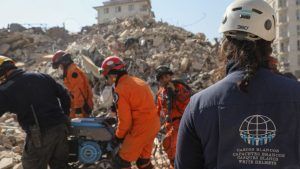White hulls: Argentina's humanitarian aid tool in its foreign policy strategy and international insertion
Humanitarian aid is an interesting tool that Argentina has to develop its foreign policy strategy and international integration. Many regions, such as Sub-Saharan Africa, the Middle East, or the Anglo-parlante Caribbean, are one of the key elements to design a South-South or Triangular cooperation bond, together with the missions to maintain peace, among others. For many countries in these regions, with which Argentina does not have a history of dense and intense relations, Cascos Brancos has been the great first approach to building a positive agenda.
Argentina is based on its humanitarian aid on the principles of impartiality, neutrality, independence and humanitarianism, and much of this tradition that Argentina bears is due to the White Bushes, since it was the national body of the design and implementation of humanitarian assistance par excellence (Virasoro, 2022). In this sense, White Cascos makes no distinction when providing help. Humanitarian aid is active at the request of a State concerned. Assistance teams are ad hoc form and the criterion is established by conciliating the needs to be covered on the ground and the budget lines.
The body of Cascos Brancos was created in 1994 as an instrument to combat hunger and poverty within a committee of the Presidency of the Nation. Humanitarian aid is traditionally framed in a North-South cooperation model, where a developed country helps other developing countries. In this context, the Carlos Menem government (1989-1999) sought to bring Argentina together with a group of developed countries that had specialized humanitarian assistance bodies.

A milestone in humanitarian aid and building solidarity multilateralism
Cascos White mark- an important milestone in humanitarian aid. With its creation, the participation of developing countries in this type of task began. Today Argentina has a valid voice, a brand, in terms of international humanitarian agenda and efforts to build solidarity multilateralism that can enable South-South cooperation to take advantage of the great lines that developed countries type in management and guide humanitarian aid. In this sense, Argentina has its own capacity (given by political will, the work of the Ministry of Foreign Affairs and the human capital of volunteers) that other middle-income countries do not have it.
With the passing of time and product of work together with the organization of the United Nations and the Organization of American States (OAS) and its renewed co-sponts, the type of assistance missions was employed and the White Cascos were acquiring increasing prestige and international recognition. From assistance missions in natural disasters, more complex scenarios of social and political decomposition have gone on. In line with these changes, the institution has been improved with a growing process of professionalization. The absorption of White Cascos to the structure of the Ministry of Foreign Affairs and the involvement of its technical staff (diplomatic career) has backed the above-mentioned prestige and recognition.
A milestone in humanitarian aid under the South-South cooperation approach
Recapitulando, Cascos Branco represents a whole milestone in humanitarian aid if it occurs from the South-South cooperation approach (contrary to the North-South). It implies a different way of understanding the simple response to disasters, to act under the paradigm of “hazard risk management”. It is a comprehensive approach that contains the mitigation and prevention of vulnerabilities, the most operational arm of responses, and the recovery in desiguaitarian societies where threats are of various natures (Cancilleria Argentina, 2021). The form of illustration, the passage of an earthquake in a densely populated area, with housing crisis, high levels of poverty and lack of resources and essential logistic chains, not only generates more damage, but also hinders recovery.
In the year 2021, Cascos Brancos had already installed more than seven hundred missions in seventy-three countries, of five continents (Cancilleria Argentina, 2021). The missions are computed beyond sending inputs. Within this first great universe, we can mention the mission in the United States after Hurricane Katrina (2005), and missions in Haiti (2010 and 2012), as examples of missions for natural disaster management. Among other missions of another type are the mission in Tunisia following Libyan collapse and border emergency (2011), the mission in Iraq due to the conflict in Syria (2014), the mission in South Sudan to attend refugee camps, the mission in Lebanon in the context of the Syrian refugee crisis (2016) and the missions in Mozambique (2015 and 2017) to assist the population after strong floods and to strengthen food production techniques.

Humanitarian aid in crisis scenarios
Recently, in the last two years, Cascos Brancos has acted in two important scenarios. On the one hand, in 2022, Cascos Brancos has played an important humanitarian aid mission at the Polish-Ukranian and Romanian-Ukranian borders to collaborate with the management of the refugee flow. On the other hand, during this year 2023, a rescue team was sent to Turkey to assist in the rescue tasks following the February earthquake, in addition to shipments of inputs to that country and the Syrian Arab Republic.








Comments